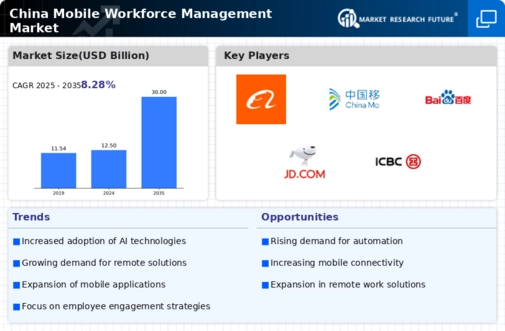Rising Demand for Remote Work Solutions
The mobile workforce-management market in China is experiencing a notable surge in demand for remote work solutions. As organizations increasingly adopt flexible work arrangements, the need for effective management tools becomes paramount. In 2025, it is estimated that approximately 30% of the workforce in urban areas will engage in remote work, necessitating robust mobile solutions to facilitate communication and task management. This shift is driving investments in mobile applications that enhance productivity and collaboration among remote teams. Companies are seeking platforms that offer real-time updates, task tracking, and performance analytics, which are essential for maintaining operational efficiency. Thus, the mobile workforce-management market is positioned for significant growth as businesses adapt to these evolving work dynamics.
Increased Focus on Data Security and Compliance
As businesses in China increasingly rely on mobile workforce-management solutions, the focus on data security and compliance is intensifying. Organizations are becoming more aware of the risks associated with mobile data access, prompting them to seek solutions that ensure robust security measures. In 2025, it is anticipated that 60% of companies will prioritize data protection features in their mobile workforce-management tools. This trend is driven by stringent regulations regarding data privacy and security, compelling businesses to adopt compliant solutions. Consequently, The mobile workforce-management market is evolving by incorporating advanced security protocols, such as encryption and multi-factor authentication, to address these concerns. This heightened emphasis on security is likely to propel market growth as organizations strive to protect sensitive information.
Technological Advancements in Mobile Applications
Technological advancements are playing a crucial role in shaping the mobile workforce-management market in China. The proliferation of smartphones and tablets, coupled with improved internet connectivity, has enabled the development of sophisticated mobile applications tailored for workforce management. In 2025, it is projected that mobile app usage among businesses will increase by 40%, as organizations leverage these tools to streamline operations. Features such as GPS tracking, real-time data analytics, and automated reporting are becoming standard in mobile applications, enhancing their appeal. This trend indicates a shift towards more integrated solutions that not only manage tasks but also provide insights into workforce performance. Consequently, the mobile workforce-management market is likely to witness substantial growth driven by these technological innovations.
Growing Importance of Analytics in Workforce Management
The growing importance of analytics in workforce management is reshaping the mobile workforce-management market in China. Businesses are increasingly recognizing the value of data-driven decision-making to enhance operational efficiency and employee performance. In 2025, it is projected that 50% of organizations will implement analytics tools within their mobile workforce-management solutions. These tools provide insights into workforce productivity, resource allocation, and project timelines, enabling managers to make informed decisions. The integration of analytics into mobile applications is likely to enhance their functionality, making them indispensable for modern businesses. As a result, the mobile workforce-management market is expected to expand as companies seek solutions that offer comprehensive analytics capabilities.
Government Initiatives Supporting Digital Transformation
Government initiatives in China aimed at promoting digital transformation are significantly impacting the mobile workforce-management market. Policies encouraging the adoption of digital technologies across various sectors are fostering an environment conducive to innovation. In 2025, the government is expected to allocate over $10 billion to support digital infrastructure development, which will directly benefit mobile workforce-management solutions. These initiatives are designed to enhance productivity and competitiveness among businesses, particularly in manufacturing and services. As companies align with government objectives, the demand for mobile workforce-management tools that facilitate compliance and efficiency is likely to increase. This supportive regulatory framework is thus a key driver of growth in the mobile workforce-management market.

















Leave a Comment